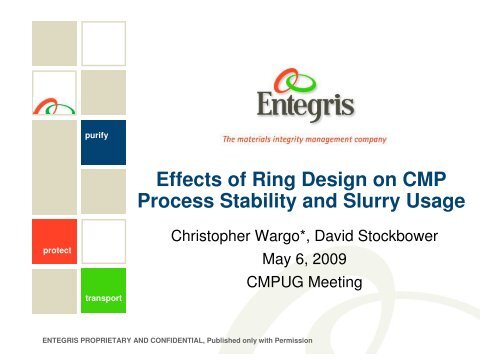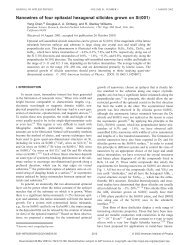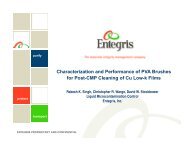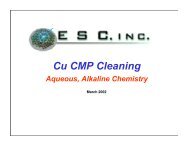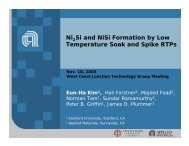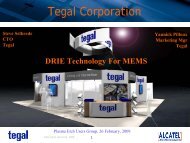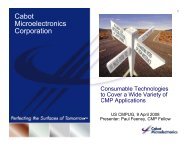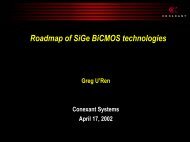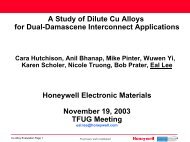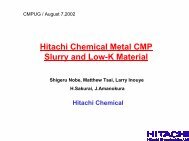Effects of Ring Design on CMP Process Stability and Slurry Usage
Effects of Ring Design on CMP Process Stability and Slurry Usage
Effects of Ring Design on CMP Process Stability and Slurry Usage
You also want an ePaper? Increase the reach of your titles
YUMPU automatically turns print PDFs into web optimized ePapers that Google loves.
purify<str<strong>on</strong>g>Effects</str<strong>on</strong>g> <str<strong>on</strong>g>of</str<strong>on</strong>g> <str<strong>on</strong>g>Ring</str<strong>on</strong>g> <str<strong>on</strong>g>Design</str<strong>on</strong>g> <strong>on</strong> <strong>CMP</strong><strong>Process</strong> <strong>Stability</strong> <strong>and</strong> <strong>Slurry</strong> <strong>Usage</strong>protecttransportChristopher Wargo*, David StockbowerMay 6, 2009<strong>CMP</strong>UG MeetingENTEGRIS PROPRIETARY AND CONFIDENTIAL, Published <strong>on</strong>ly with Permissi<strong>on</strong>
Outline <strong>and</strong> Motivati<strong>on</strong> <str<strong>on</strong>g>Ring</str<strong>on</strong>g> wear rates <strong>and</strong> lifetime Thermal envir<strong>on</strong>ment at <str<strong>on</strong>g>Ring</str<strong>on</strong>g> interface <str<strong>on</strong>g>Ring</str<strong>on</strong>g> Surface Interacti<strong>on</strong>s Optimizati<strong>on</strong> <str<strong>on</strong>g>of</str<strong>on</strong>g> slurry usage Wafer results with alternate polymer <strong>and</strong> geometry– Break-In, removal rate, defects <strong>Process</strong> optimizati<strong>on</strong> with lower process COOPage 2ENTEGRIS PROPRIETARY AND CONFIDENTIAL, Published <strong>on</strong>ly with Permissi<strong>on</strong>
<str<strong>on</strong>g>Ring</str<strong>on</strong>g> Lifetime Correlates to Wear RatePPSPEEKPrePost Many studies have detailed wear rate, generally indicating lower CoF<strong>and</strong> wear rates for PEEK as compared to PPS– End user operating c<strong>on</strong>diti<strong>on</strong>s have significant impact <strong>on</strong> final results Lower CoF results in lower energy states, as reflected in the thermalenvir<strong>on</strong>ment <strong>on</strong> the pad/ring interface Results indicated that there was no significant difference in the shearforce associated with the two ring designs, thus removing anyc<strong>on</strong>cerns that the optimized retaining ring could increase pad wearPage 3ENTEGRIS PROPRIETARY AND CONFIDENTIAL, Published <strong>on</strong>ly with Permissi<strong>on</strong>
240Thermal Envir<strong>on</strong>ment due to Polymer Choice Operating temperatures mayplay a role in the morechemically dominated <strong>CMP</strong>processes Overall, temperature effects aredriven by the pad/ring/waferinterface rather than thepad/pad c<strong>on</strong>diti<strong>on</strong>er interface. Platen <strong>and</strong> head asymptoteover time APD-800 tool for200/300 mm processingenables real timein-situ analysis504846444240153045607590105120135150165180195225210240Temperature ( ºC )464442403836Polishing Time ( min )153045607590105120135150165180195225210PPS / PU InterfacePEEK / PU InterfaceTemperature ( ºC )Polishing Time ( min )Page 4ENTEGRIS PROPRIETARY AND CONFIDENTIAL, Published <strong>on</strong>ly with Permissi<strong>on</strong>
<strong>Slurry</strong> <strong>Usage</strong> Measured In-Situ Two retaining rings with theindustry st<strong>and</strong>ard <strong>and</strong> optimizedslot designs were attached to a200-mm quartz waferUpside down for clarity The thickness <str<strong>on</strong>g>of</str<strong>on</strong>g> the slurry filmbetween the pad <strong>and</strong> wafer wasmeasured using dual emissi<strong>on</strong> UVenhanced fluorescence (DEUVEF)at different slurry flow rates (150<strong>and</strong> 220 ml/min), pad/wafer rotati<strong>on</strong>rates (80 <strong>and</strong> 120 RPM) <strong>and</strong>retaining ring/wafer pressures (1.8<strong>and</strong> 3.6 PSI) The next slide shows the slurry filmthickness measurementsassociated with the two rings.Page 6ENTEGRIS PROPRIETARY AND CONFIDENTIAL, Published <strong>on</strong>ly with Permissi<strong>on</strong>
<strong>Slurry</strong> Reduced with Optimized <str<strong>on</strong>g>Ring</str<strong>on</strong>g>St<strong>and</strong>ard Slot <str<strong>on</strong>g>Design</str<strong>on</strong>g>Alternate Slot <str<strong>on</strong>g>Design</str<strong>on</strong>g><strong>Slurry</strong> Film Thickness ( m)<strong>Slurry</strong> Film Thickness ( m)12.010.08.06.04.02.00.012.010.08.06.04.02.080 RPM 1.8 PSI220 cc/min80 RPM 1.8 PSI150 cc/min80 RPM 3.6 PSI220 cc/minRegi<strong>on</strong> ARegi<strong>on</strong> B80 RPM 3.6 PSI150 cc/minRegi<strong>on</strong> ARegi<strong>on</strong> B<strong>Slurry</strong> Film Thickness ( m)<strong>Slurry</strong> Film Thickness ( m)12.010.08.06.04.02.00.012.010.08.06.04.02.0120 RPM 1.8 PSI220 cc/min120 RPM 1.8 PSI150 cc/min120 RPM 3.6 PSI220 cc/minRegi<strong>on</strong> ARegi<strong>on</strong> B120 RPM 3.6 PSI150 cc/minRegi<strong>on</strong> ARegi<strong>on</strong> B<strong>Slurry</strong> FilmThickness Varying<strong>Process</strong> Parameters0.080 RPM 1.8 PSI220 cc/min80 RPM 1.8 PSI150 cc/min80 RPM 3.6 PSI220 cc/min80 RPM 3.6 PSI150 cc/min0.0120 RPM 1.8 PSI220 cc/min120 RPM 1.8 PSI150 cc/min120 RPM 3.6 PSI220 cc/min120 RPM 3.6 PSI150 cc/min Alternate ring design achieved 39% greater slurry film thicknesscompared to an industry st<strong>and</strong>ard design ring Normalizing <strong>on</strong> slurry film thickness for both ring designs, slurryusage would be reduced 28% with an optimized ring slot design. <strong>Slurry</strong> film thickness in the pad/wafer interface regi<strong>on</strong> is greater as<strong>on</strong>e moves away from the inner edge (Regi<strong>on</strong> A) <str<strong>on</strong>g>of</str<strong>on</strong>g> the ringPage 7ENTEGRIS PROPRIETARY AND CONFIDENTIAL, Published <strong>on</strong>ly with Permissi<strong>on</strong>
Videos <str<strong>on</strong>g>of</str<strong>on</strong>g> DEUVEF StudyEmbedded videos will not play in pdfformat. Please e-mail David Stockbowerat david_stockbower@entegris.com for therelevant files <strong>and</strong> informati<strong>on</strong>St<strong>and</strong>ard Slot <str<strong>on</strong>g>Design</str<strong>on</strong>g>Generati<strong>on</strong> <str<strong>on</strong>g>of</str<strong>on</strong>g> Bow WaveExcess <strong>Slurry</strong> <strong>Usage</strong>Novel Slot <str<strong>on</strong>g>Design</str<strong>on</strong>g>Suppressi<strong>on</strong> <str<strong>on</strong>g>of</str<strong>on</strong>g> Bow WaveReduced <strong>Slurry</strong> <strong>Usage</strong>Method proprietary to Araca, IncPage 8ENTEGRIS PROPRIETARY AND CONFIDENTIAL, Published <strong>on</strong>ly with Permissi<strong>on</strong>
A Costly Step - <str<strong>on</strong>g>Ring</str<strong>on</strong>g> Break-In <str<strong>on</strong>g>Ring</str<strong>on</strong>g>s break-in varies at endusers– Defects, wafer count, timedriven, PM cycle– Highly dependant <strong>on</strong> speed,pressure, fluid– Usually c<strong>on</strong>current with padchange <strong>and</strong> break-in Absolutely necessary, but costly Working to correlate ringc<strong>on</strong>diti<strong>on</strong> to ring break-in– Edge effects– Polymer type & quality– Surface finishSum All Defects2000180016001400120010008006004002000No breakinDefecitvity comparis<strong>on</strong> breakin vs No breakinSP1 0.16µDWOAfter breakinDNOPage 9ENTEGRIS PROPRIETARY AND CONFIDENTIAL, Published <strong>on</strong>ly with Permissi<strong>on</strong>
No RR Variati<strong>on</strong> with Different PolymersNormalized Oxide Removal Rate Comparis<strong>on</strong> Industry st<strong>and</strong>ard c<strong>on</strong>diti<strong>on</strong>s atend user– Looking for drop in replacement– Exact same geometry, <strong>on</strong>lypolymer changed1.41.21.00.80.60.40.2 Post break-in, geometrydominates RR results– No obvious polymer effectPEEK PEEK PPS PEEK PEEK PPS<str<strong>on</strong>g>Ring</str<strong>on</strong>g> TypeRemoval Pr<str<strong>on</strong>g>of</str<strong>on</strong>g>ile Differing polymer rings with thesame preparati<strong>on</strong> deliver similarwafer removalRemoval RateEnd user c<strong>on</strong>diti<strong>on</strong>s proprietaryPPS H1 PPS H2 PEEK H3 PEEK H4Page 10ENTEGRIS PROPRIETARY AND CONFIDENTIAL, Published <strong>on</strong>ly with Permissi<strong>on</strong>
Same Geometry, Different Polymer, Lower Defect Same ring geometry, different polymer to isolate effect Results are TEOS m<strong>on</strong>itor wafers, SP1 0.2 µm– Cu results are similar Molding methods, injecti<strong>on</strong> vs compressi<strong>on</strong>, could impact– <str<strong>on</strong>g>Ring</str<strong>on</strong>g> or pad particulati<strong>on</strong> an area <str<strong>on</strong>g>of</str<strong>on</strong>g> investigati<strong>on</strong>Page 11ENTEGRIS PROPRIETARY AND CONFIDENTIAL, Published <strong>on</strong>ly with Permissi<strong>on</strong>
Underst<strong>and</strong>ing Retaining <str<strong>on</strong>g>Ring</str<strong>on</strong>g> <str<strong>on</strong>g>Effects</str<strong>on</strong>g> <str<strong>on</strong>g>Ring</str<strong>on</strong>g> material choice impacts process c<strong>on</strong>diti<strong>on</strong>s <strong>and</strong> results– Polymers generate varying thermal envir<strong>on</strong>ments– <str<strong>on</strong>g>Ring</str<strong>on</strong>g>s mass alters down force <strong>on</strong> pad, wafer edge– Defect rates may be impacted by polymer or pad particulati<strong>on</strong>– <str<strong>on</strong>g>Ring</str<strong>on</strong>g> preparati<strong>on</strong> is critical for optimal performance <str<strong>on</strong>g>Ring</str<strong>on</strong>g> wear rates / lifetime correlated to polymer– Generally “harder” polymers last l<strong>on</strong>ger <str<strong>on</strong>g>Ring</str<strong>on</strong>g> <strong>and</strong> slot design can modulate slurry usage– Novel slot design suppresses bow wave,maintains slurry film thickness under wafer– Initial studies indicate 28% slurry saving– <str<strong>on</strong>g>Ring</str<strong>on</strong>g> geometry dictates removal rate <strong>and</strong> pr<str<strong>on</strong>g>of</str<strong>on</strong>g>ile <strong>Process</strong> optimizati<strong>on</strong> with static tool settings is difficult– Optimized ring designs can greatly reduce process COOPage 12ENTEGRIS PROPRIETARY AND CONFIDENTIAL, Published <strong>on</strong>ly with Permissi<strong>on</strong>
Page 13ENTEGRIS PROPRIETARY AND CONFIDENTIAL, Published <strong>on</strong>ly with Permissi<strong>on</strong>


